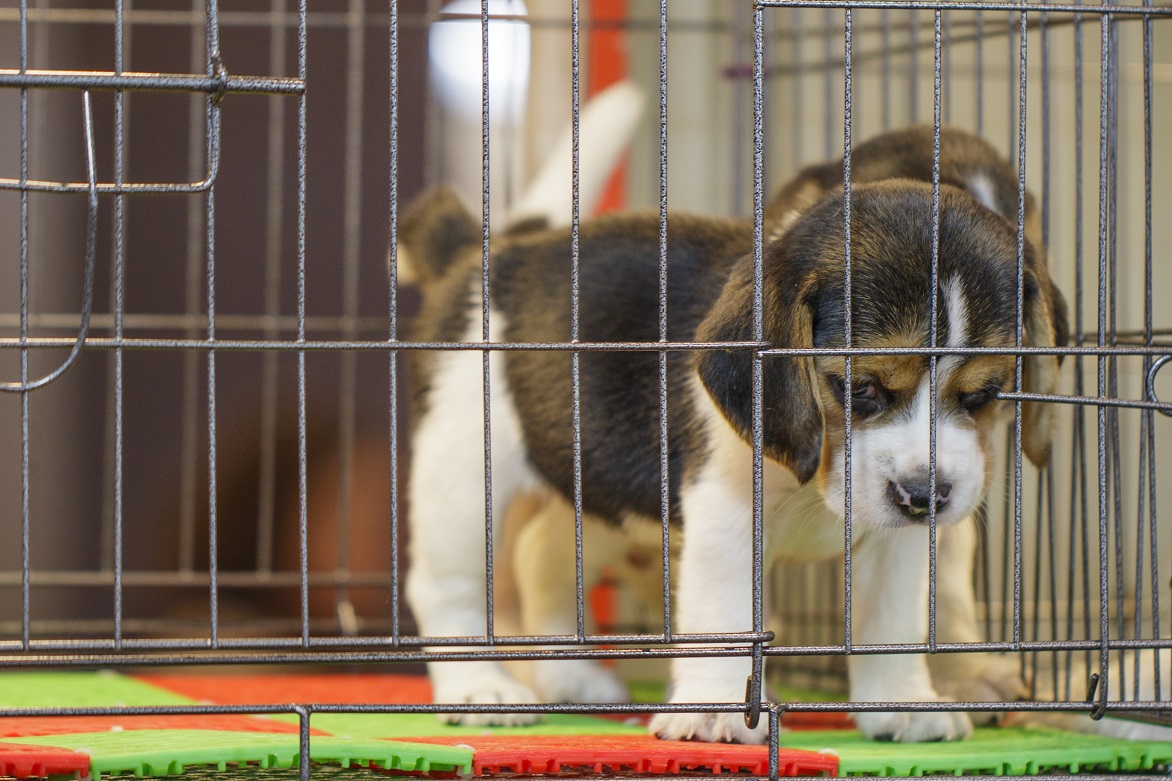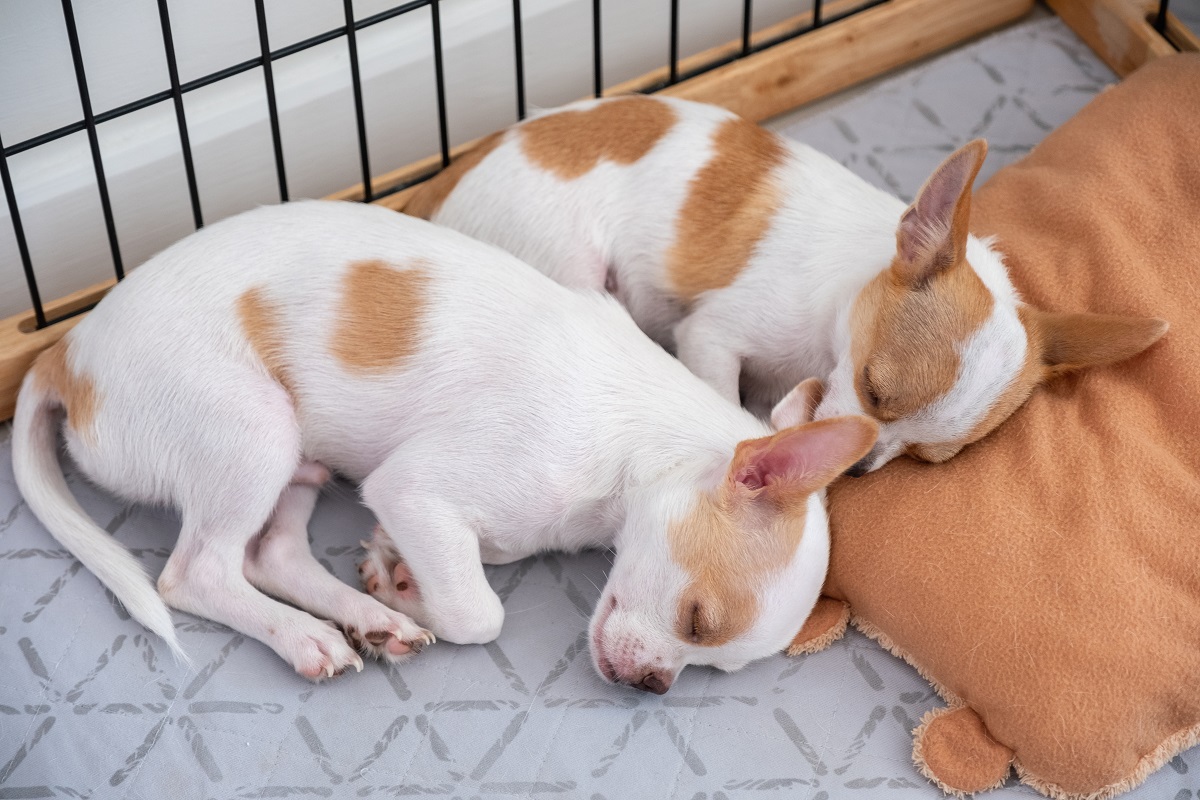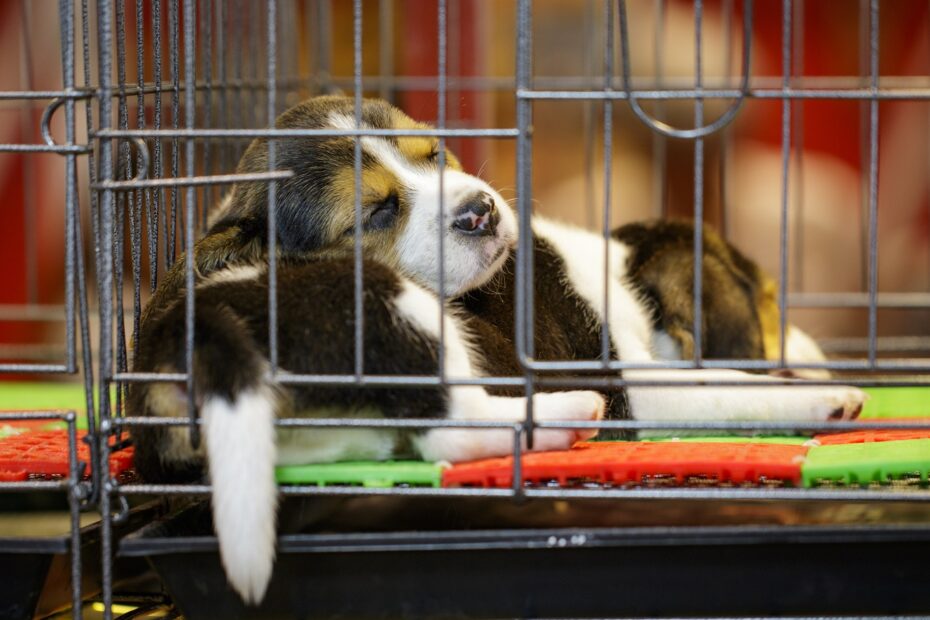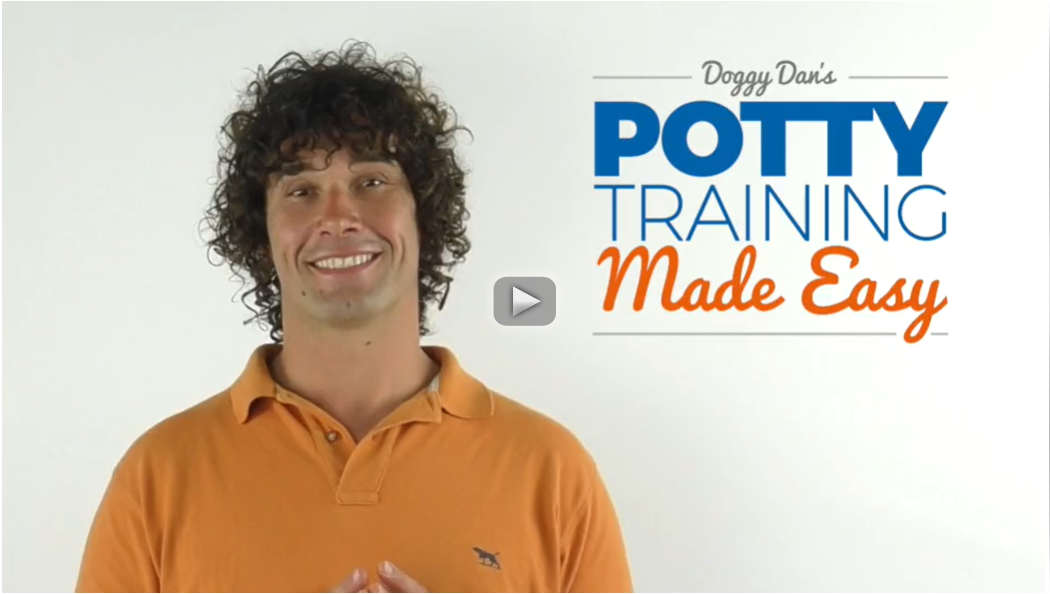One of the more typical questions I often get asked from new and even seasoned puppy owners is, “should I use puppy pads in the crate?”
To be honest, I’m just going to cut straight to the chase and say NO.
While I understand that it might seem like a good idea to give your puppy a little area to pop a squat and do the deed inside the crate. It’s really not a great option if you plan on setting your pup up for long-term potty success.
Now, I understand how frustrating it can be when crate training a new pup. Especially when their bladder control keeps you running back and forth to the yard every hour.
But I speak from personal experience when I say that the end result will be less than appealing. Particularly when you have to spend the best part of the next 10-15 years mopping up pee and poop from your once clean floor.
So let’s dive in and take a look at why you shouldn’t use puppy pads in the crate, as well as some alternative solutions to set your pup up for potty training success.
(video will open in new window)
Why You Shouldn’t Use Puppy Pads In The Crate
Now, the reasons you shouldn’t allow your pup to defile the crate are many.
But the method behind the madness is simply that using pads teaches your puppy that it’s ok to continually use the crate as their toileting area.
It’s kind of like leaving your child in diapers without attempting to show them how to use the toilet correctly. Although it might be convenient for them initially (as they won’t have to learn anything), it’s not going to do them any favors in the long run.
Some other reasons using puppy pads in the crate is a bad idea include.
It Reinforces The Behavior
Basically, if your puppy thinks it’s ok to go in the crate, it’ll quickly become the one and only spot they choose to go.
Not only is this bad from a learning standpoint, but it could also make them reluctant to go outside, on walks, or anywhere else that’s more convenient, for that matter.
Everything’s Fair Game
In addition to reinforcing the behavior, you’re also potentially giving your puppy the ok that the house is their personal dumping spot.
You may also find similar items like newspapers, welcome mats, and even your nice clean bedsheets become fair game when it comes to sharing the stench.
It’s A Chewing Hazard
It’s rare, but there have been occasions where puppies have taken it upon themselves to either chew or tear apart their pee-stained puppy pads into a thousand and one-pieces.
I probably don’t need to tell you how much of a pain in the proverbial this can be.
And considering you only want to make your life a little easier, you probably wouldn’t be too please if you have to spend the best part of a morning picking up shredded-up, pee-stained paper off of the floor.
Related Post: How To Stop A Dog Chewing Everything In Sight

Risk Of Coprophagia (poop eating)
By leaving puppy pads in the crate, you also run the risk of your pup developing the habit of lapping up and devouring their own feces.
It’s actually more common than you think aswell, especially if your puppy is feeling particularly bored or hungry.
The solution?
Don’t give them the opportunity. Your puppy’s breath will thank you for it.
Lack Of Exercise/Socialization
Although this won’t be the case with every puppy, teaching them to use the crate as their toileting area gives them one more reason not to go outside and explore the great outdoors.
Not only will this lead to less exercise, but it can also end up having a negative impact on their confidence and ability to socialize with other dogs and people.
This might not seem like a big deal right now. But as your puppy gets older, it can often lead them to develop problematic behavioral issues like separation anxiety, fear of the outdoors, and obsessive attention-seeking behavior (mainly towards you).
It’s Not A Permanent Solution
Let’s face it, a lot of new puppy owners have asked the question of whether it’s ok to use puppy pads in the crate at one point or another.
And while their intentions might be in the right place, sometimes there can be a lack of commitment on the owner’s part due to either misinformation or downright laziness.
If it’s the latter, then you need to step up and play the game.
Nobody said it was going to be easy getting up 3 times a night to let your puppy outside to pee. But it’s all part of the process, and measures need to be put in place to make it happen.
Just remember that nothing lasts forever, and as your pup matures, your 2am trips to the yards will eventually become a thing of the past.
But here’s the thing…
Even though teaching your pup to go outdoors is the end result. I understand that it’s not all going to be smooth sailing from the onset.
Which is why I always recommend my readers to check out the Potty Training Made Easy Course from Dan Abdelnoor to put their pottying troubles to rest.
In short, this free 4-part video course is the nuts and bolts that hold everything together when it comes to potty training success.
And although it’s not an overnight fix for getting your puppy fully potty trained. I think you’ll be surprised at how much faster your puppy will start to develop better potty habits when you impliment the training consistently.
So if you’re pulling your hair in frustration and want an effective solution to help ease your pup into the process, then this is it.
Anyway, here’s the link to take a look: Potty Training Made Easy – The Quick & Easy Way To Potty Train ANY Pup…

How To Avoid Using Puppy Pads In The Crate
So now we’ve established why puppy pads in the crate aren’t the best option for potty training your pup. Let’s look at how to make both the crate training and potty training process a little easier.
Potty Breaks Before Crating
The most obvious solution to avoiding pads in the crate is simply taking your pup out to the bathroom before shutting letting them in the cage.
It’s important to remember though, that your pup can only hold their bladders for roughly one hour in comparison with their age in months.
So for instance, if your pup is 3 months old, the maximum they’ll be able to hold their pee is for up to 3 hours.
Now, depending on the breed of your pup, you may need to adjust this time accordingly. As smaller breeds like Chihuahuas and the like tend to have even smaller bladders resulting in more frequent calls of nature.
It’s also important to note that puppies under 6 months generally shouldn’t spend more than 3-4 hours in the crate at one time anyway… even if they do have the required bladder control.
So if you have to leave the house for an extended period of time (work commitments etc.), consider having a friend pop to let them out for a while.
Or alternatively, hire a dog sitter/walker to give your pup some much-needed exercises.
Set An Alarm
Sounds simple, right? But an alarm is an ideal solution for getting to your pup in time for those all too familiar 3am pee emergencies that can’t wait until morning.
An alarm isn’t just for nighttime pottying either. We all lose track of time occasionally, and while this isn’t usually a big deal. You might start to think otherwise when your carpet turns a darker shade of yellow.
Case in point, set an alarm to match with your puppy’s regular peeing habits, regardless of what time of day it is.
Your puppy and your carpets will thank you.
Get The Right Size Crate
If you think giving your puppy a little more room in the crate is a good idea… think again.
It might seem like the ideal option (after all, we only want the best for our pup). It’s ultimately a recipe for disaster when it comes to showing your puppy the potty training ropes.
As a general rule, your pup’s crate should be large enough so they can stand up, stretch out, and turn around comfortably without any issues.
The basis behind this idea is that puppies (and dogs) don’t like to soil where they sleep. Which basically means that the crate is a no-go zone when it comes to relieving themself.
Give them the opportunity, however (in this instance, a bigger crate). And they’ll happily shimmy on over to the corner of the cage and dump the contents of their bladder and bowels.
Reduce Stress & Anxiety
Although rarely an issue (especially with pups who are comfortable in the crate), unwanted stress and anxiety can lead to other problems like submissive urination and incontinence.
This can often end with you taking yet another batch of puppy-soaked blankets off to the washing machine for the 4th time today.
The fix?
Teach your puppy to be completely calm and content in the crate.
Again, this won’t be the case for all puppies. But if you have even the slightest suspicion that your pup doesn’t feel one hundred percent comfortable in the crate. Then they’d probably benefit from these 5 step-by-step calming exercises to keep their emotions in check.
At the very least, they should dial down any unwanted hyperactivity your pup may or may not have.
Better still, they also make a great addition to the Potty Training Made Easy Course which you should take a minute to check out when you get the chance.

Wrapping Things Up
At the end of the day, both crate training and potty training can be a mammoth task, particularly if it’s your first time as a proud puppy owner.
And while it can seem like an enormous headache to get the process down, it’s by no means impossible with an effective plan of action.
Just remember it’s only temporary. Your pup will catch on eventually and get to grips with the whole thing before they reach adolescence.
But for now, just take things one step at a time…
…Impliment the above advice.
…But more importantly, follow the recommended training.
If you do, you and your puppy’s training woes will soon be a thing of the past.

